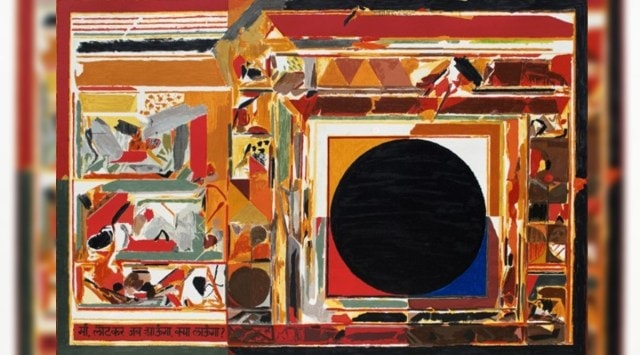Paris-based artist Sujata Bajaj on what makes Progressive artist SH Raza’s 1981 painting Maa essential viewing
The very first time I saw Maa was on the walls of Chemould Art Gallery in Bombay in the early 1980s. I was young. The painting made an overwhelming impression: the title Maa has the power and gravity of the panchatatva.
 Currently on view at the SH Raza exhibition at Centre Pompidou, Paris. (Source: The Raza Foundation)
Currently on view at the SH Raza exhibition at Centre Pompidou, Paris. (Source: The Raza Foundation) Making art accessible to children, one artist and one artwork at a time
Artwork: Maa
Artist: SH Raza
Where can it be viewed? Currently on view at the SH Raza exhibition at Centre Pompidou, Paris
Why?
Every time I see this painting — or just a picture of it — it strikes me that it conveys a very strong message: it emphasizes how important it is for an artist to be connected with his or her origins. Strong roots allow the artist to fly and work anywhere in the world.
The very first time I saw Maa was on the walls of Chemould Art Gallery in Bombay in the early 1980s. I was young. The painting made an overwhelming impression: the title Maa has the power and gravity of the panchatatva.
While I was admiring it something very interesting happened. The artists Bal Chhabda and MF Husain came by and both, like me, were mesmerised by Maa. They decided to buy it together and share the painting so to speak. They kept it for several years. I was lucky to have had many meals admiring this painting in their homes. Later, they sold the work. Being an abstract artist and colourist myself and coming from the land of colours, Shekhawati in Rajasthan, I connect with this painting organically. Its colours have depth and there is tension and flow. Maa conveys the artist’s magnetic attraction to his roots in Bharat. Raza’s love for India has been evident in several works of his, and also in numerous titles he chose. I recall a work titled Shekhawati, a huge painting where he had written “place of pilgrimage” in Hindi “Tirtha sthal”, a homage and gratitude for Rajasthan and its colours that so deeply inspired him throughout his life.
At one point, Raza had reached a crossroads in his painting. Living and working in France but very strongly connected to India he was in his own words a bit confused. Maa gave him the direction, Indian themes were to become his main source of inspiration. Maa in some ways called him home, and he actually did return to India after a gap of quite a few years.
This painting is a symbol of gratitude to his Maa, to his land of birth. All these aspects make Maa very special. It’s a landmark painting.
(Sujata Bajaj is a Paris-based artist who is known to work in varied media. She is a 2003 Raza Foundation Award recipient)





- 01
- 02
- 03
- 04
- 05


























